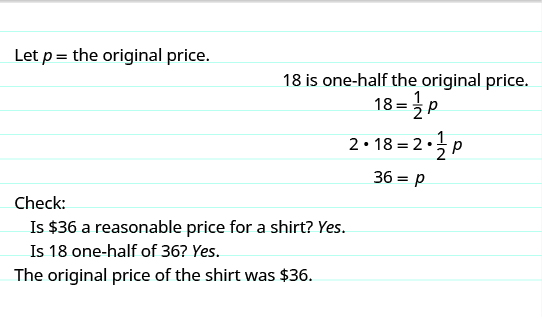| << Chapter < Page | Chapter >> Page > |
Pete bought a shirt on sale for which is one-half the original price. What was the original price of the shirt?
Step 1. Read the problem. Make sure you understand all the words and ideas. You may need to read the problem two or more times. If there are words you don't understand, look them up in a dictionary or on the Internet.
Step 2. Identify what you are looking for. It's hard to find something if you are not sure what it is! Read the problem again and look for words that tell you what you are looking for!
Step 3. Name what you are looking for. Choose a variable to represent that quantity. You can use any letter for the variable, but it may help to choose one that helps you remember what it represents.
Step 4. Translate into an equation. It may help to first restate the problem in one sentence, with all the important information. Then translate the sentence into an equation.

Step 5. Solve the equation using good algebra techniques. Even if you know the answer right away, using algebra will better prepare you to solve problems that do not have obvious answers.
Step 6. Check the answer in the problem and make sure it makes sense.
| Write the equation. |
|
| Multiply both sides by 2. |
|
| Simplify. |
|
Step 7. Answer the question with a complete sentence.
If this were a homework exercise, our work might look like this:

Joaquin bought a bookcase on sale for which was two-thirds the original price. What was the original price of the bookcase?
$180
Two-fifths of the people in the senior center dining room are men. If there are men, what is the total number of people in the dining room?
40
We list the steps we took to solve the previous example.
Let's use this approach with another example.
Yash brought apples and bananas to a picnic. The number of apples was three more than twice the number of bananas. Yash brought apples to the picnic. How many bananas did he bring?
| Step 1. Read the problem. | |
| Step 2. Identify what you are looking for. | How many bananas did he bring? |
| Step 3.
Name what you are looking for.
Choose a variable to represent the number of bananas. |
Let |
| Step 4.
Translate. Restate the problem in one sentence with all the important information.
Translate into an equation. |
 |
| Step 5. Solve the equation. |
|
| Subtract 3 from each side. |
|
| Simplify. |
|
| Divide each side by 2. |
|
| Simplify. |
|
| Step 6. Check: First, is our answer reasonable? Yes, bringing four bananas to a picnic seems reasonable. The problem says the number of apples was three more than twice the number of bananas. If there are four bananas, does that make eleven apples? Twice 4 bananas is 8. Three more than 8 is 11. | |
| Step 7. Answer the question. | Yash brought 4 bananas to the picnic. |

Notification Switch
Would you like to follow the 'Prealgebra' conversation and receive update notifications?